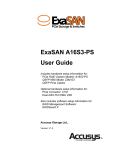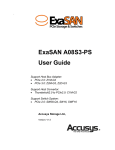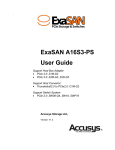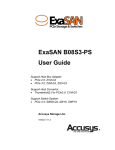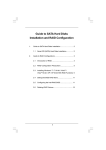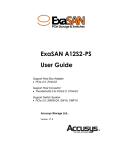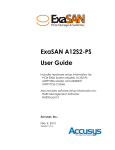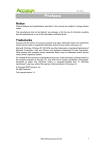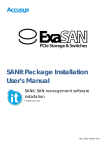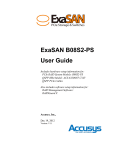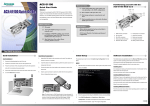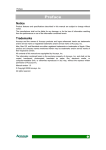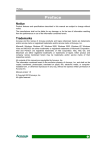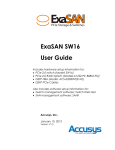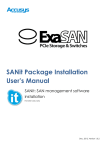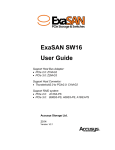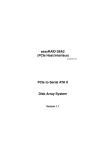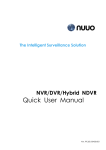Download User`s Manual Template
Transcript
`
ExaSAN A08S2-TS
User Guide
Support Host Convertor:
Thunderbolt2.0 to PCIe2.0: C1M-G2
Accusys Storage Ltd.,
Version: V1.0
Revision Sheet
Revision Sheet
Release
No.
V1.0
Date
Revision Description
10/16/2014 Initial release
User Guide
Page i
PREFACE
Notice
The product features and specifications described in this guide are subject to change without
notice.
The manufacturer shall not be liable for any damage, or the loss of data resulting from the
performance or use of the information contained herein.
About This Guide
Congratulations on your purchase of the ExaSAN (pronounced X-sa-SAN) A08S2-TS, The 8
bay PCIe 2.0 tower model of the ExaSAN family, specifically designed for all post production
storage. It delivers stability, exceptional performance, and scalable capacity.
This guide also contains instructions for installing and using the ExaSAN A08S2-TS system and
RAID (Redundant Array of Independent Disks) technologies and RAIDGuardX (ExaSAN’s RAID
management software).
If you are new to RAID and RAIDGuardX, this guide will help you become familiar with the
technology, and assist you in setting up and using RAID on the A08S2-TS. If you are already
familiar with ExaSAN, use this guide as a reference for implementing your ExaSAN A08S2-TS
solution to achieve maximum performance and reliability.
For details of hardware installation, setup, configuration and considerations, see
Chapter 1, “Introducing ExaSAN PCIe2.0 Storage System”
Chapter 2, “Preparing to Install ExaSAN A08S2-TS”
Chapter 3, “Installing ExaSAN A08S2-TS”
Chapter 4, “Using RAIDGuardX”
Chapter 5, RAID Overview
Guide to Conventions
Inside the double boxes are important information that users should be aware of:
Caution
This indicates the existence of a potential hazard that could result in
personal injury, damage to your equipment or loss of data if the safety
instruction is not observed.
Note
This indicates useful tips on getting the most from your Accusys RAID
system.
User Guide
Page ii
Trademarks
Accusys and the names of Accusys products and logos referenced herein are trademarks
and/or service marks or registered trademarks and/or service marks of Accusys Storage Ltd.
Xsan, Mac, Mac OS, and Macintosh are either registered trademarks or trademarks of Apple.
Other product and company names mentioned herein may be trademarks and/or service marks
of their respective owners.
All contents of this manual are copyrighted by Accusys Storage Ltd.
The information contained herein is the exclusive property of Accusys Storage Ltd. and shall not
be copied, transferred, photocopied, translated on paper, film, electronic media, or computerreadable form, or otherwise reproduced in any way, without the express written permission of
Accusys Inc.
Document version V1.0
Date Published: October, 2014
© Copyright 2014 Accusys Storage Ltd.
All Rights Reserved.
This device complies with Part 15 of the FCC Rules. Operation is subject to the following two
conditions: (1) this device may not cause harmful interference, and
(2) this device must accept any interference received, including interference that may cause
undesired operation.
User Guide
Page iii
ExaSAN A08S2-TS User Guide
Table of content
Page #
Notice.............................................................................................................................................................ii
About This Guide ........................................................................................................................................ii
Guide to Conventions ...............................................................................................................................ii
Trademarks .................................................................................................................................................iii
Table of content ......................................................................................................................................... iv
1.
Introducing ExaSAN PCIe 2.0 Storage System .............................................................................. 1-1
1.1
1.1.1
1.1.2
Overview.................................................................................................................................. 1-1
What is the ExaSAN Solution.............................................................................................................1-1
ExaSAN A08S2-TS features...............................................................................................................1-1
1.2
What’s in the Box ................................................................................................................... 1-4
1.3
Your A08S2-TS at a Glance................................................................................................... 1-5
1.3.1
ExaSAN A08S2-TS ............................................................................................................................1-5
1.3.1.1
A08S2-TS Front Panel & LED Indicators ............................................... 錯誤! 尚未定義書籤。
1.3.1.2
Beeper Codes .......................................................................................... 錯誤! 尚未定義書籤。
1.3.1.3
Disk Mapping .......................................................................................... 錯誤! 尚未定義書籤。
1.3.1.4
Disk Tray and LED Indicators ................................................................ 錯誤! 尚未定義書籤。
1.3.1.5
A08S2-TS Rear Panel ............................................................................. 錯誤! 尚未定義書籤。
1.3.1
Z2M-G3 ............................................................................................................ 錯誤! 尚未定義書籤。
1.4
2.
3.
What Else You Need ............................................................................................................... 1-9
Preparing to Install ExaSAN A08S2-TS ......................................................................................... 2-1
2.1
Precaution for Handling the System ..................................................................................... 2-1
2.2
Choosing the Location for the System .................................................................................. 2-1
2.3
Electrical Power ...................................................................................................................... 2-1
2.4
Operating Environment ......................................................................................................... 2-2
2.5
Security .................................................................................................................................... 2-2
Installing the ExaSAN A08S2-TS ................................................................................................... 3-1
3.1
3.1.1
3.1.2
3.1.3
3.2
3.2.1
3.2.2
3.3
Installing the System .............................................................................................................. 3-1
Installing Disk Drives .........................................................................................................................3-1
Installing the HBA Card .....................................................................................................................3-2
Connecting cable to A08S2-TS ........................................................................ 錯誤! 尚未定義書籤。
Powering the System On and Off ........................................................ 錯誤! 尚未定義書籤。
Powering On ..................................................................................................... 錯誤! 尚未定義書籤。
Powering Off .................................................................................................... 錯誤! 尚未定義書籤。
Install driver and GUI............................................................................................................ 3-3
3.3.1
Installing ExaSAN driver and GUI RAIDGuardX .............................................................................3-3
3.3.1.1
Installing driver and GUI on MAC and Windows ....................................................................3-3
3.3.1.2
Installing driver and GUI on Linux ...........................................................................................3-4
User Guide
Page iv
3.3.2
Confirm the ExaSAN RAID system driver on OS ..............................................................................3-8
3.3.2.1
Confirming the ExaSAN RAID system driver on Mac .............................................................3-8
3.3.2.2
Confirming the ExaSAN RAID system driver in Windows ......................................................3-9
3.3.3
Confirm LEDs on HBA ......................................................................................................................3-9
3.4
3.4.1
3.4.2
3.4.3
4.
Create Array ......................................................................................................................... 3-10
Check on new Volume in Disk Utility of MacOS ............................................................................3-10
Check on new volume in Disk Management of Windows ................................................................3-10
Check on new volume by fdisk command on Linux .........................................................................3-10
Using RAIDGuardX GUI................................................................................................................. 4-1
4.1
RAIDGuardX Overview ........................................................................................................ 4-1
4.1.1
RAIDGuardX at a Glance ...................................................................................................................4-2
4.1.1.1
Menu Bar ...................................................................................................................................4-2
4.1.1.2
RAIDGuard X main console .....................................................................................................4-3
4.1.2
Adding Controller ...............................................................................................................................4-4
(1) DAS – add controller locally ..................................................................................................................4-4
(2) SAN – add controller remotely ...............................................................................................................4-5
4.1.3
Planning your RAID ...........................................................................................................................4-6
4.1.4
Creating an Array ...............................................................................................................................4-7
4.1.5
Email Notification ............................................................................................................................4-10
4.1.6
Preference .........................................................................................................................................4-11
4.1.6.1
Disk Lag Proof Mode ..............................................................................................................4-11
4.1.6.2
NCQ ........................................................................................................................................4-12
4.1.6.3
SMART Mode .........................................................................................................................4-12
4.1.6.4
Beeper .....................................................................................................................................4-13
4.1.6.5
Equalization Mode ..................................................................................................................4-13
4.1.6.6
Cache .......................................................................................................................................4-14
4.1.6.7
MISC .......................................................................................................................................4-15
4.1.7
Option ...............................................................................................................................................4-16
4.1.7.1
Slicing .....................................................................................................................................4-16
4.1.7.2
LUN Map ................................................................................................................................4-18
4.1.7.3
Expansion ................................................................................................................................4-19
4.1.7.4
Migrations ...............................................................................................................................4-21
4.1.7.5
Snapshot ..................................................................................................................................4-23
4.1.7.6
Health Center ..........................................................................................................................4-26
4.1.7.7
Unlock Drives .........................................................................................................................4-27
4.1.8
Updating the ExaSAN RAID system Firmware ...............................................................................4-29
4.1.8.1
Preparing the Firmware Update Files ......................................................................................4-29
4.1.8.2
Installing the Firmware Update Files ......................................................................................4-29
5.
RAID Overview ................................................................................................................................. 5-1
5.1
How RAID Works .................................................................................................................. 5-1
5.2
Data Storage Methods ............................................................................................................ 5-1
5.2.1
5.2.2
5.2.3
5.3
5.3.1
5.3.2
5.3.3
5.3.4
5.3.5
6.
Data Striping .......................................................................................................................................5-1
Data Mirroring ....................................................................................................................................5-1
Data Parity ..........................................................................................................................................5-2
RAID Levels ............................................................................................................................ 5-2
RAID 0: Striping.................................................................................................................................5-2
RAID 1: Mirroring ..............................................................................................................................5-2
RAID 5: Independent data disks with distributed parity .....................................................................5-2
RAID 6: Independent data disks with two Independent parity schemes .............................................5-2
RAID 0+1: Striped set with Mirroring ................................................................................................5-3
Appendices ........................................................................................................................................ 6-1
User Guide
Page v
Appendix A: FAQs .............................................................................................................................. 6-2
Appendix B: Icons ............................................................................................................................... 6-4
Appendix C: Customer Service and Support .................................................................................... 6-6
User Guide
Page vi
1.
1.
User Guide
Introduction
Introducing ExaSAN PCIe 2.0 Storage System
1.
1.
1.1
Introduction
Introducing ExaSAN PCIe 2.0 Storage System
Overview
1.1.1 What is the ExaSAN Solution
Developed by Accusys Storage Ltd., a worldwide leader in RAID (Redundant Array of
Independent Disks) storage systems, ExaSAN (pronounced “X-sa-SAN”) is a family of storage
and switch products that take advantage of well known PCIe (PCI Express) technology speeds,
standards, and roadmap.
The current ExaSAN products employ PCIe2.0 protocol that provides 5 Gb/s per lane transfers.
With 4 lane QSFP (Quad SFP) connector and cable, ExaSAN can transfer up to 20 Gb/s by
using single connection.
Post production work including non-linear editing (NLE) requires high bandwidth storage to
quickly move the volume of data being processed and ExaSAN storage solution meets those
demands. The high bandwidth provided by ExaSAN technology allows the client to complete
editing tasks in a much shorter time to save time and money.
ExaSAN solution, including its complete line of rack mount RAID systems, tower RAID systems,
PCIe switch systems and accessories.
ExaSAN A08S2-TS support to build DAS environment with extreme and modern Thunderbolt
connection, cable hot pluggable helping user to easily switch different workstation with same
huge storage.
A08S2-TS DAS environment
1.1.2 ExaSAN A08S2-TS features
Below are the key features of the A08S2-TS. They are the reasons why ExaSAN is the best
RAID solution for a power user, working on studio, or individual work space.
1. Host Interface
PCIe2.0 5Gb/s x4 lanes, for transfers up to 20Gb/s
2. Disk Interface
Support 8 x 3.5” SAS/SATA HDD(hard disks) or 2.5”SSD (flash disks)
User Guide
Page 1-1
1.
Introduction
3. RAID Controller
Hardware XOR/Multi-Parity engine
2GB DDRII-800 memory, ECC-protected, support up to 4GB
4. Software Specifications
Multiple RAID levels: 0,1,5,6, 0+1, and JBOD
Up to 4 independent disk arrays
RAID capacity partitioning: up to 16 slices
Support up to 64 LUNs
Variable stripe sizes: 256 (KB)
Selective initialization method with background initialization
Online RAID set expansion and level migration
Controller and Disk Cache Control to optimize read/write performance
Support write-back and write-through caching
Automatic drive insertion/removal detection and fast disk rebuilding
Online bad block data recovery and reallocation
Online disk scrubbing and data refresh and parity regeneration
Disk health monitoring by S.M.A.R.T.
NVRAM-based transaction log and auto parity resynchronization
Array roaming and disk traveling with redundant on-disk metadata
Array recovery to restore RAID configurations
Dual firmware images for firmware recovery
Disk Lag Proof technology to guarantee disk timely response
Equalization mode to smooth the performance of sequential data transfers
5. Management
Java-based GUI, cross-platform executable
Enclosure components monitoring and control via GUI
LED indicator for RAID & enclosure status
Event logging to text file with event viewer
Event notification by email (SMTP)
Centralized multiple RAID system management
Supports both in-band and out-of-band management
Support firmware upgrade via GUI
Support SNMP
Support remote management
6. Enclosure
FAN, Power, Temperature status LED indication in the front faceplate.
Dimensions: L: 374mm, W:175mm, H:394mm
Weight: 11.5 Kg (w/o drives)
User Guide
Page 1-2
1.
Introduction
7. Support OS
Windows 7, 8, 2008 and 2012 (32/64bit)
Linux: Red Hat, SUSE, Fedora, CentOS etc.
MAC: OS X 10.5, 10.6, 10.7, 10.8, 10.9 and later
8. Operating Conditions
Humidity: 5% - 85%
Operating Temperature: 0C – 40C
Certification: RoHS, UL, CE, FCC, C-Tick, BSMI
9. Support Host adapter
Convertor: C1M-G2 (Thunderbolt2.0 to PCIe)
10. Support Cable
Copper cable:2M
User Guide
Page 1-3
1.
Introduction
1.2 What’s in the Box
Your ExaSAN A08S2-TS is shipped in special packaging to provide protection during
transportation. Carefully check your carton contents against the included packing list, or the
inside flap of the box, and your original purchase order. You should have the items as described
in the sections below.
A08S2-TS packing list
Contact your Accusys System Integrator/Value Added Reseller or Accusys Customer Service
(see Appendix C “Customer Service and Technical Support” for more information) to report any
missing item.
The Accessories package includes the following items. These items can also be ordered and
shipped separately from Accusys.
1. Disk tray x 8
2. Packing list
3. Installation DVD
4. Screw pack
5. Key x 2
6. AC Power Cord cable
7. EU, AU, UK converter
8. 2M QSFP copper cable
9. C1M-G2 Convertor
10. ExaSAN A08S2-TS Storage
User Guide
Page 1-4
1.
Introduction
1.3 Your A08S2-TS at a Glance
This section helps you get familiar with the physical appearance of your ExaSAN A08S2-TS.
1.3.1 ExaSAN A08S2-TS
1.3.1.1 A08S2-TS Front Panel & LED Indicators
There are two columns of LEDs on the front panel, which correspond to the following:
Disk 1 status
Disk 1 activity
Disk 2 status
Disk 2 activity
Disk 3 status
Disk 3 activity
Disk 4 status
Disk 4 activity
Disk 5 status
Disk 5 activity
Disk 6 status
Disk 6 activity
Disk 7 status
Disk 7 activity
Disk 8 status
Disk 8 activity
Name
1
2
Power
Button
Disk status
User Guide
Description
Control the power to the RAID system (Push the button for 5
seconds to shut down the power manually.)
Green is normal
Red is abnormal by drive defect
Green/ Red Switching Hard disk drive condition is normal
and transiting (Rebuild/Migrate/Expand).
Page 1-5
1.
3
Disk activity
Introduction
Blue Blinking is accessing
1.3.1.2 Beeper Codes
Controller Status
Turn on the Controller
System Panic
Controller Work Status, ex:
Disk init, disk rebuild, disk expansion, disk
migratrion, disk snapshot, etc.
System Problem, ex:
Fan issue, Power issue, RAID error, etc.
Create array successfully
Memory test error
Beeper mode
One short beep
Long beep
Regularly repeating one short
beep
Regularly repeating three short
beeps
One short beep
Regularly repeating three rapid
short beeps
1.3.1.3 Disk Mapping
Disk 1
Disk 2
Disk 3
Disk 4
Disk 5
Disk 6
Disk 7
Disk 8
1.3.1.4 Disk Tray and LED Indicators
Disk Status
LED #1 (Access LED)
LED #2 (Status LED)
Disk Online
Steady Green
Disk Fail
Steady Red
User Guide
Page 1-6
1.
No Disk
Steady Red
Disk Lock
Steady Green
Disk Access
Flashing Blue
Steady Green
Disk Initialization
Flashing Blue
Steady Green
Disk Rebuild
Flashing Blue
Disk Expansion
Flashing Blue
Introduction
Rebuild Drives: Steady Red
Original Drives: Steady Green
Extend Drives: Steady Red
Original Drives: Steady Green
Migrating Drives > Original Drives
Migrating Drives: Steady
Green
Original Drives: Steady
Green
Migrating Drives < Original Drives
Disk Migration
Flashing Blue
Migrating Drives: Steady Red
Original Drives: Steady
Green
Migrating Drives = Original Drives
Disk Health
Center Action
Flashing Blue
User Guide
Migrating Drives: Steady
Green
Original Drives: Steady
Green
Steady Green
Page 1-7
1.
Introduction
1.3.1.5 A08S2-TS Rear Panel
Figure 10: A08S2-TS back view
No.
Name
Description
Host access LED (top):
1
PCIe host port
Flashing Blue indicates host accessing is in progress.
No light indicates no host accessing.
Host connected LED (bottom):
Flashing Green indicates the controller is connected
normally.
No light indicates the controller connected abnormal.
2
Debug port
For engineer debugging only
3
door lock
Lock and unlock the back panel door of drives
4
Power Supply
Connects to a power source with a power cord.
5
Redundant
Power Supply
(Optional)
Support redundant 300W power supply.
User Guide
Page 1-8
1.
Introduction
1.3.1.6 C1M-G2
No.
Name
Description
DAS mode in green/
1
Mode/Access indicator
2
Link indicator
Blue light on when PCIe link up
3
QSFP port
For ExaSAN storage or switch host port
4
Thunderbolt port
For Thunderbolt 2.0 host
5
SAN/DAS mode switch
Set to SAN or DAS mode
6
Power
12V power
SAN mode in white/
Refer to C1M-G2 document on website (http://www.accusys.com.tw/products/accessories/c1m-new/document.html)
for more detail.
1.4 What Else You Need
When you purchased your ExaSAN system, additional hardware, software and accessories may
be required to fully take advantage of this system. The following describes the software and
hardware which you may need to purchase separately. If you still have questions, please
consult with your ExaSAN reseller for more details.
1. Disk drive: A08S2-TS supports both SAS and SATA interface HDD/SSD drives in 3.5” and
2.5” dimension. Recommend using Enterprise level of the same model, size, and firmware.
The A08S2-TS HDD compatibility list is on the Document section of A08S2-TS’s web page.
2. Host system computer: A08S2-TS + C1M-G2 support modern workstation equipped with
Thunderbolt port, e.g. New MacPro, Macbook Pro, etc.
Note
C1M-G2 is passed by standard Thunderbolt Certification by Intel and MacOS.
3. Driver Software: A08S2-TS required Firmware/ Driver/ BIOS/ GUI are all included in the
DVD ROM inside A08S2-TS package. Also, you can download it from the website
(http://www.accusys.com.tw/support/download.html), folder path is /Download /ExaSAN
/ForDAS
User Guide
Page 1-9
2.
2.
User Guide
Preparation
Preparing to Install ExaSAN A08S2-TS
2.
2.
Preparation
Preparing to Install ExaSAN A08S2-TS
To ensure safe and smooth operation of your ExaSAN A08S2-TS, it is essential that you choose
an appropriate location for the system, provide an appropriate operating environment, and
adequate power for all components of the system. As you plan for installation, follow the
guidelines below to ensure that the system and its environment are safely and appropriately
positioned for efficient operation and service.
2.1 Precaution for Handling the System
Take the following precautions to avoid damage to the system or potential injury to you.
1. Prepare a flat, sturdy surface before removing the system from its packaging. The table or
cart that will hold the system should be as close as possible to the system carton.
2. Ensure that all power switches have been turned off and all power cords disconnected to
prevent personal injury and damage to the hardware.
3. Static electricity can damage electronic components of your system. Follow the guidelines
below to avoid such damage:
a. Work in a static-free environment
b. Wear a grounded anti-static wrist strap
c. Store uninstalled components in anti-static bags
d. Handle circuit boards by their edges and avoid touching chips and connectors
2.2 Choosing the Location for the System
The ExaSAN A08S2-TS is designed as a tower solution. Depending on where your desk or
rackmount cabinet or other install location is, you should keep the following points in mind when
determining where to place your system.
1. Measure the amount of available space on your desk. The amount of space required for the
A08S2-TS is L: 374mm, W:175mm, H: 394mm
2. Measure the distance between any two components that need to be connected via cable(s).
This measurement will help you determine the length of the required cable(s). Or if you’ve
already purchased the cables, determine the proximity of the components in question.
3. Leave sufficient room, at least two inches, around the unit to allow air ventilation.
4. Do not block or cover any of the ventilation holes in the front and back panels of the unit.
Consistent airflow is essential to keeping the system operating efficiently.
5. Allow additional room at the front and back of the unit for service.
6. The ExaSAN A08S2-TS uses several cables and cords. It’s a good idea to determine how
they will be arranged at the rear of the system, and where the cables will be routed to
connect to the host systems and RAID disk systems.
2.3 Electrical Power
At your chosen location for the ExaSAN A08S2-TS, make sure that the electrical circuitry and
power outlets are sufficient for the combined power needs of all hardware components. To plan
for safe and adequate power to the system, follow these guidelines:
1. Check the documentation for all hardware components at the chosen location to determine
their power requirements. Then make sure that the available power supply for that location
is sufficient for the planned components.
2. When possible use surge protectors or power conditions as part of the installation.
User Guide
Page 2-1
2.
Preparation
3. When planning for electrical power, make sure you have more power than the total power
requirements specified for all components. Also make certain that the power load is
distributed evenly among circuits to that location. Consult an electrician or other expert if you
need assistance with planning for the power needs for your components.
4. Make sure that the power outlets for all hardware components are grounded according to
local and national standards. Consult an electrician if you need assistance with grounding.
2.4 Operating Environment
The operating environment for the ExaSAN A08S2-TS must meet certain requirements:
1. Verify that the temperature range of the chosen location is within the limits established for
the system and all other components.
2. Make certain that the chosen location has adequate ventilation to maintain the necessary
temperature range.
3. If there are multiple hardware components installed at the chosen location, consider
additional cooling measures to assure efficient operation of the system and other
components.
4. Environment parameters:
a. Operating temperature: 0°C to 40°C (32°F to 104°F)
b. Operating humidity: 5-85%, non-condensing
c. Storage humidity:5%-95%, non-condensing
2.5 Security
To ensure the security of the ExaSAN A08S2-TS, make certain that the chosen location meets
your security requirements.
User Guide
Page 2-2
3.
3.
User Guide
Installation
Installing the ExaSAN A08S2-TS
3.
3.
Installation
Installing the ExaSAN A08S2-TS
Follow the steps in this chapter to prepare your ExaSAN A08S2-TS system for installation.
3.1 Installing the System
Follow the instructions in this section to hook up all your hardware components of the ExaSAN
A08S2-TS system. Do not turn the power of any individual component on until instructed. When
all components are properly connected, follow the instructions in section 3.3.1 “Powering On” to
turn the components on in the prescribed order.
3.1.1 Installing Disk Drives
Follow the steps below to install your HDDs. .
1. Place the HDD with connector align with the edge of the disk tray.
2. Secure HDD with screws as below figure.
Four screws for 3.5” HDD
Three screws for 2.5” HDD
3. Slide the disk tray into the disk bays on the back of the chassis.
Insert tray into A08S2-TS
4. Push the tray inward until the tray firmly connects and you hear the tray click into place.
User Guide
Page 3-1
3.
Installation
5. Repeat for all drives to be installed into the A08S2-TS.
Note
The hard drives in a RAID system should match in size and speed. All
drives in an array should be identical models with the same firmware
version.
3.1.2 Connecting A08S2-TS with C1M-G2
1. Set C1M-G2 to DAS mode, connect QSFP cable, Thunderbolt cable and power cord.
2. Connect the other end of QSFP connector to ExaSAN A08S2-TS.
4. Power on A08S2-TS to ready in a few seconds, and then you can connect Thunderbolt cable
to host server. Note that, Thunderbolt is Hot Pluggable.
User Guide
Page 3-2
3.
Installation
3.2 Install driver and GUI
Before installing driver and GUI, make sure all connections and power on sequences are all
correct.
3.2.1 Installing ExaSAN driver and GUI RAIDGuardX
Installation files can be found in DVD of accessory, you can also download the latest version
from our website if necessary, check the website if any new version
(http://www.accusys.com.tw/support/download.html). If you need more info or tech support,
please contact reseller of ExaSAN product or Accusys FAE Dept. (see Appendix C “Customer
Service and Technical Support” for more information)
Note
For Mac/Windows platform:
Executing installer package to install driver and GUI at the same time.
For Linux platform:
Driver and GUI must be built in kernel and executed separately.
3.2.1.1 Installing driver and GUI on MAC and Windows
Driver and GUI Installation
1. Insert the DVD into the DVD-ROM of the MAC or Windows.
2. For Mac, execute double clicking “/MAC Installer/Vx.x/Accusys_IP_MAC3.1.8.mpkg".
For Windows, execute “/Windows installer/Vx.x/Accusys_Win_x.x.exe”.
Follow the onscreen instructions to install and click Restart to complete installation.
GUI installation successful page
User Guide
Page 3-3
3.
Installation
3.2.1.2 Installing driver and GUI on Linux
Following procedures contain 2 procedures;
Driver installation
GUI RAIDGuardX installation
Driver Installation
You must have your Linux system with developmental environment and kernel source, in other
words you should select the adequate packages on the menu list during installation. Check
“Development Tools” Then click “Optional Packages” to select all packages when you install
your Linux OS.
1. Copy the ExaSAN RAID system driver files onto your desktop. Open a terminal window and
type the following commands to change the source files directory.
# cd 'root/Desktop/Linux_Drv_x.x.x
# make
# ls
Verify that driver ACS6x.ko has been compiled. If so, please type the following command
to install it.
# insmod ACS6x.ko
# lsmod
User Guide
Page 3-4
3.
Installation
The driver (ACS6x) should be now loaded in Linux driver module list.
Note:
1. Login as root, install driver will need root permission.
2. If you want to start the driver automatically, please put the compiled driver (ACS6x.ko) to
directory as follows:
#cp ACS6x.ko /lib/modules/ “uname –r”/kernel/drivers/scsi
[For RHEL, CentOS, etc]
#depmod –a
[For SLES OS]
#vi /etc/modprobe.d/unsupported-modules
(Modify the line “allow_unsupported_modules 1”)
#mkinitrd
(Warning: recommend to backup /boot/initrd-`uname -r` before doing "mkinitrd", if any
trouble)
#reboot
User Guide
Page 3-5
3.
Installation
GUI RAIDGuardX Installation
Before installing RAIDGuardX, make sure the RAID HBA drivers is already installed in your
Linux OS.
1. You will need two source files; GS (RAIDGuardX Server) and GC (RAIDGuardX Client), you
can download from Accusys website: http://www.accusys.com.tw/support/download.html.
GS location: /{ExaSAN model}/GUI/Server/Linux.zip
GC location: /{ExaSAN model}/GUI/Client/x.x.x.zip
2. Create folder “Accusys”, and unzip GS/GC files to subfolder GS and GC.
3. Perform GS, open a terminal console, and enter the following commands:
# cd /Accusys/GS/Linux/X.X.X
# chmod -R 777 SourceCode
# cd /Accusys/GS/Linux/X.X.X/SourceCode/
# ./make.sh
# cd /Accusys/GS/Linux/X.X.X/AP_Accusys/
# ./DTRGuiSrv_64
Note: Leave the GS terminal there and DON’T close it. Open another new terminal to
perform GC.
4. Perform GC, first to make sure the Java version is higher than 1.6, enter the following
commands:
# java –version
User Guide
Page 3-6
3.
Installation
If your Java version is earlier than 1.6, please go to www.java.com to upgrade. If version is
ok, please enter the following commands:
# cd /Accusys/GC/x.x.x./x.x.x/
# java –jar RAIDGuardX.jar
Now you can add controller to config and manage ExaSAN system.
User Guide
Page 3-7
3.
Installation
3.2.2 Confirm the ExaSAN RAID system driver on OS
3.2.2.1 Confirming the ExaSAN RAID system driver on Mac
After installing the ExaSAN RAID system HBA driver on the Mac host server, confirm the driver
has been properly installed with the following steps.
1. Click on About This Mac and lick on the More Info… button, then Click on the System
Report… button.
2. MacOS recognize ExaSAN as Fibre device, under the Hardware category, click on Fibre
Channel to bring up information. If HBA (or C1M) has been correctly installed, it will appear
a Fibre Domain. If there is a SAN volume, it will show as a SCSI logical unit
User Guide
Page 3-8
3.
Installation
3.2.2.2 Confirming the ExaSAN RAID system driver in
Windows
After installing the ExaSAN RAID system HBA driver on a Windows based host server, confirm
the driver has been properly installed.
Go to Control Panel -> System Properties -> Hardware -> Device Manager (depending on
the version of Windows, the path may vary). If the driver has been correctly installed, the HBA is
listed with the ACS6x identifier (actual name may vary) as Storage Controllers.
device manager in Windows platform
Caution
If you see the HBA listed as an unknown device under Windows, follow
the driver installation steps to reinstall the driver. If you do not see the
HBA under Device Manager, Windows does not detect the card. Power
off the host server to reseat the HBA.
3.2.3 Confirm LEDs on HBA
Verify the Link and Access LED on the backplane of the HBA are appropriately lit according to
your installation (Refer to Section 1.5.2 ExaSAN QSFP Host Bus Adapter). Onboard LEDs of
Z2M indicate more link status, please refer to the Appendix A FAQ Q3.
User Guide
Page 3-9
3.
Installation
3.3 Create Array
Array can be easily created by RAIDGuard X (refer to Section: Creating an Array). Make sure
LUN mapping (refer to Section: LUN mapping) is setup, and then volume should be appeared
on OS, now, enjoy the high speed access to new ExaSAN Volume.
3.3.1 Check on new Volume in Disk Utility of MacOS
3.3.2 Check on new volume in Disk Management of Windows
3.3.3 Check on new volume by fdisk command on Linux
# fdisk -l
User Guide
Page 3-10
4.
4.
User Guide
How to Use
Using RAIDGuardX
5.
4.
RAID
Using RAIDGuardX GUI
4.1 RAIDGuardX Overview
RAIDGuardX is a powerful GUI management tool, which support local and remote monitoring of
multiple controllers that are connected to the same network. RAIDGuardX have to work with 2
components: RAIDGuardX-Server and RAIDGuardX-Client.
RAIDGuardX-Server: Communicates with RAIDGuardX-Client and RAID controller, it MUST be
installed on which host directly connected to RAID system.
Note
RAIDGuardX Server is default installed in ExaSAN Switch, therefore, in
the SAN environment, you can run RAIDGuardX Client alone to
manage RAID controller.
RAIDGuardX-Client: A java based console to manage and monitor RAID system, which MUST
works with RAIDGuardX-Server via local server or switch remotely.
Feature
Easily manage and morning by Java Based GUI
Support multiple RAID system
Multi-platform and operating system
Remote monitoring
Event notification
RAIDGuardX-Client console
It is consist of menu bar and main console.
- menu bar
- main console
User Guide
5.
RAID
4.1.1 RAIDGuardX at a Glance
4.1.1.1 Menu Bar
The menu bar across the top contains the following functions:
Function
File
Controller
Help
Description
Exit
Load Controller List
Close the program
Refresh the controller list
Language
Manual Add Controller
English and Japanese are supported
Manually search and add the controller
Update
Update RAID controller firmware (System Code, Boot
Code, etc.)
Dump controller log
Search
Download the event log for troubleshooting
Search keyword in RAIDGuard X
Help Center
Displays the help for RAIDGuard X
Note
Run Dump controller log, events are automatically generate a zip file
and saved on directory as below;
1.
2.
3.
MacOS: save in /Applications/RAIDGuard X/Log
Windows: save in /program file/accusys/exasan/log
Linux: save in /{RAIDGuard X install folder}/log
Please send the log file to your vendor or Accusys tech support team to
analyze. [email protected]
User Guide
5.
RAID
4.1.1.2 RAIDGuard X main console
Function
Monitoring Buttons
Management Buttons
User Guide
Description
Add controller into RAIDGuard X (for DAS only)
Remove controller from RAIDGuard X
Create array in the RAID system
Delete array in the RAID system
Email to set email notification
Drive Lag Proof Enable/ Disable
NCQ mode Enable/ Disable
SMART Mode Enable/ Disable
Preference
Beeper Enable/ Disable
Equalization Enable/ Disable
Cache of controller and drives can be enable/disable
MISC for controller Time setup
Slicing an existing array for multiple slices
LUN Map setup for multiple slices
Expansion with new drive into an array
Option
Migration between different RAID level
Snapshot for backup data in a particular time
Health Center for check array status
Unlock Drives from locked mode
5.
RAID
4.1.2 Adding Controller
RAIDGuardX can manage the RAID controller locally or remotely via intranet access.
Two configurations to add RAID controller into RAIDGuardX Client.
1) DAS - Click icon Add Controller in the main page of RAIDGuardX Client locally.
2) SAN - Clicking Manually Add Controller in controller tab to add remotely.
Following steps for add controller in detail;
(1) DAS – add controller locally
1. Click Add Controller to display a list of available controllers on local and network.
2. Click on a controller and enter password, default is 00000000 (8 zeros). (you can assign a
name to the controller for remark)
3. Click Add to main page.
Note
To change the controller password, refer to Section MISC.
User Guide
5.
(2) SAN – add controller remotely
In a SAN connection, you can manually add controller via network.
1. Click on Controller on the menu bar and select Manual Add controller.
2. Enter the Server or Switch IP.
3. Click Search and wait for the Serial Number to populate.
4. Type the password (default is 00000000) for the controller.
5. Click Add to finish adding the controller.
Note
To remove a controller from RAIDGuardX list, select a controller and
then click the Remove Controller button to remove the controller from
the table. When the popup window appears, select Yes.
User Guide
RAID
5.
RAID
4.1.3 Planning your RAID
Before create RAID, it is a good idea to become familiar with the variety of configurations, or
schemes, that are available for the ExaSAN RAID storage. This section describes these
schemes and illustrates how each RAID level is applied.
RAID Level
RAID 0
RAID 1
RAID 5
RAID 6
RAID 0+1
Description
Capacity
Striping, the fastest and most
efficient array type but offers no faulttolerance
Mirroring, All disks have the same
data
Block-level striping with distributed
parity, one disk fault tolerant
Block-level striping with double
distributed parity, two disks fault
tolerant
Combines the advantage of R0 and
R1, provides optimal speed and
reliability
Total of all drives
Total of one drive
Total of all drives minus one drive
Total of all drives minus two
drives
One-half the total capacity of
drives (Sum of RAID 1 member
sets)
When configuring RAID, you may take the follow items into consideration:
1. Are you using a DAS or SAN environment?
2. Do you currently have more than one RAID or JBOD?
3. Which is more important, transfer speed or data security? One or two disk fault tolerance?
4. Do you need multiple volume or single volume on your RAID systems?
5. Do you have to consider the metadata volume for SAN software?
6. Do you consider using Global spare drives?
7. The number of disk drives used determines the speed of the RAID created. Take into
account the desired speed when configuring RAID.
User Guide
5.
RAID
4.1.4 Creating an Array
When the RAID controller is first configured, an array needs to be set up. This array tells the
controller how many disks to use and what their function should be.
Follow the steps below to create an array:
1. Select the RAID level from the drop down menu. Available levels are: 0, 1, 5, 6, 0+1 and
JBOD.
Note
Each RAID level has a minimum disk requirement. This is shown in the
information to the right of the drop down list. For example, RAID 5
requires at least 3 drives.
2. Select the sector size from the drop down menu. Available sector sizes are 512 bytes
(default) and 4096 bytes. The sector size 4096 bytes is only supported by Windows XP, and
over 2 Terabyte function is used. For other OSs, please select 512 bytes (default)
3. Click on the drives to be added to the array. You can also click on Select all spare drivers.
Note
Unselected drives will be set to Hot (Global) spare drive. If a drive
failure, spare drive will start to rebuild automatically.
4. Select initialization mode in either On-the-fly initialization or Performance evaluation.
User Guide
5.
RAID
On-the-fly initialization – ExaSAN RAID systems
record the initialized sectors in the bitmap. All sectors
are initialized only once. The entire initialization
process will be completed faster and the
performance will be better during the initialization.
During on-the-fly initialization, 65-75% of the full
speed (of a created RAID) is still available. You can
still use the RAID system during the RAID
initialization.
Select this option (default) to ensure the
completeness of the array. If this option is selected, it
will recalculate the disk parity and data organization
(how it is arranged). The amount of time required for
the initialization process varies depending on the disk
volume.
Performance evaluation – Select to evaluate the performance of the target array. Data and
parity are not initialized. (No data protection when this mode is on).
Note
For on-the-fly option, you are able to access the array volume during
initialization. However, the RAID performance of the array will be
slightly lower than usual before the initialization is complete.
5. Assign LUN automatically. Once check this box, array will automatically assign a LUN. If
there are multiple slices, you may choose to assign LUN manually under Option.
6.
Click Create Array to complete the process. You can check the initial status in below page.
User Guide
5.
RAID
After the array has been created, the Main screen displays the newly created array with an
array number. The array initialization progress is also displayed.
Arrays are assigned numbers in the order they are created. For example, the first array created
is labeled with the “1” icon; the second array created is labeled with the “2” icon, and so forth.
Note
The ExaSAN RAID controller can support up to maximum of 4 arrays
per RAID controller
Delete an Array
1. Click on the drives containing the array to be deleted.
2. Check the Confirm box. Click Delete Array to complete the process.
Caution
When you delete an array, all data on the hard disk drives will be lost.
User Guide
5.
RAID
4.1.5 Email Notification
It may be necessary for network administrators to receive e-mails in the event of errors, alerts,
and changes to the RAID array. These alerts can be e-mailed to a maximum of 20 e-mail
addresses.
Mailing List
Enter the e-mail address(es) of people to receive controller error reports.
Click Remove to delete e-mail addresses from the list.
Click Send Test Email to check that the e-mail is working.
SMTP Setting
Mail Server Name – Enter the address of the mail server.
From Email Address – Enter the e-mail address of the mail server.
SMTP Server – requires authentication for user name and password
Check this box if your mail server requires a user name and password.
SMTP POST event
Check this box if wish to create a log for error events.
Note
1. Ask your systems administrator for SMTP Server details.
2. Not support outbound SMTP mail service, e.g. Gmail, Hotmail, Yahoo.
3. Contact to tech support for more detail.
User Guide
5.
RAID
4.1.6 Preference
4.1.6.1 Disk Lag Proof Mode
This feature ensures the stability and continuity of the RAID performance. In RAID 5 and RAID
6, DLP prevents the aging or slow responds of a single hard disk from influencing the overall
performance. The advantage of this feature will not be felt until some hard disks fail to perform
well.
DLP concept
In the event of performance degradation or delay of a single drive due to aging, the ExaSAN
RAID system reads both data and parity stripes concurrently. It bypasses the slow reads and
returns data to the host with the regenerated data and to provide stabled performance based on
the RAID parity.
Note
Although slow responds of some hard disks can be tolerated in DLP
mode, you may use S.M.A.R.T. function to check the conditions of hard
disks in an array and replace the faulty ones.
Note
This function does not support JBOD and NRAID.
User Guide
5.
RAID
4.1.6.2 NCQ
NCQ (Native Command Queuing) – This mode is designed for increasing disk drive access on
SCSI and SATA disk drives. It can do this under certain situations by allowing the individual
hard disk to internally optimize the order in which it executes the read and write requests it
receives. This can reduce the amount of unnecessary drive head movement and resulting in
better performance for work loads where multiple read/write requests and outstanding at the
same time.
This situation most often occurs in server-type applications. However, the current technology
actually slows down disk drive access in certain applications, such as video editing and
sequential reads and writes, because of the added latency induced by NCQ.
NCQ concept
The figure above illustrates the access sequence in NCQ and non-NCQ mode. The content
sequences of the two hard disks are the same: 1, 2, 3, 4. However, the access sequence in
NCQ mode may vary to improve the performance.
Note
If Equalization mode is enabled, NCQ is automatically turned off.
4.1.6.3 SMART Mode
S.M.A.R.T. is a monitoring system of disk drives to detect and report on various indicators of
reliability, in the hope of anticipating failure. ExaSAN RAID system supports S.M.A.R.T. Once
this function is selected, you can select the check interval from the drop-down list. Choose from
1 minute to 8 hours for SMART Mode to be active. The RAID controller will command each hard
disk to perform S.M.A.R.T. according to the check interval selected. The check results will be
shown as an Event message in the main menu.
When running S.M.A.R.T., the performance of the system will be slightly affected. The higher
the check frequency, the more the sequential access is influenced. It is recommended to turn off
S.M.A.R.T. if high frequency is needed. On the other hand, running S.M.A.R.T. constantly
allows you to monitor the conditions of hard disks at any time.
Different hard disk models and brands will have different attributes in the reporting of S.M.A.R.T.
Event message will show all messages generated by the hard disk.
User Guide
5.
RAID
The option of time to check disk’s S.M.A.R.T are 1,15,30,60 minutes and 2,4,8 hours. We
strongly suggest set to 8 hours. Frequently check time will reduce the life time of hard drives
4.1.6.4 Beeper
Default Beeper option is enabled, the system will sound an audible alarm in the event of an
error. Users can respond to the error promptly and carry out troubleshooting.
If the error indicated by the Beeper alarm has been resolved, you may uncheck the Beeper
option.
4.1.6.5 Equalization Mode
Regardless the transmission method, the data transmission speed cannot be guaranteed at all
times. This feature allows the continuous I/Os to operate more smoothly and substantially
reduce large fluctuations in efficiency during data transfer. For video editing, enable equalization
to prevent video frame drops.
EQ mode concept
User Guide
5.
RAID
4.1.6.6 Cache
Controller Cache – Check this box to enable the controller cache. This speeds up the data
transfer to and from the disks.
Caution
Data in cache may be erased if power down unexpected. Suggest
using a UPS (uninterruptible power supply) to prevent this scenario.
Synchronize Cache – Check this box to enable cache synchronization with drives, to ensure all
write data is correct, there is a frequently latency time within. For video capture, disable
synchronization, because the video capture needs to be able to constantly write data to the
RAID storage without long latency.
Read Pre-fetch – Identifies sequential access patterns and aggressively pre-fetches patters
into cache. From the drop down list, choose the number of stripes to pre-fetch. The default is
32; this is the recommended number.
Drive Cache – Choose which drives to cache. When more than one application accesses the
database, the first applications cache needs to synchronize with the second. Each drive
contains a built in write cache; checking these boxes chooses which drives to enable the
caching on. Caching improves the efficiency and speed of data transfer.
All Drives Cache On/All Drives Cache Off – Click this button to enable/disable the caching on
for all available drives.
User Guide
5.
RAID
4.1.6.7 MISC
MSIC (Minimal Instruction Set Computer) has standard RAID controller CPU time settings. The
time of each event is displayed in the event logs in Event message.
Controller Time – Click this button to see a calendar and to change the time and date of the
controller.
Password – Enter the new controller password. The default password is 00000000 (8 zeros).
Type another 8 characters.
Password Confirmation – Confirm the new controller password.
Note:
Do not lose your password. If it is lost, you will have to contact your
agent or the Accusys Support Team.
SNMP Notification – Select SNMPv1 or SNMPv2 to send notifications for error conditions and
possible problems to the SNMP servers. SNMP stands for Simple Network Management
Protocol.
SNMP Target – Enter the IP address for sending the SNMP notifications.
Note:
The ExaSAN RAID system supports SNMP. It can set "System on IP
networks" and allows servers to manage the system remotely.
User Guide
5.
RAID
4.1.7 Option
The Options menu provides the methods for managing array. Click on the radio button for the
required option, and then click Next to proceed.
4.1.7.1 Slicing
ExaSAN RAID slicing overcomes the inherent design of how data is stored on an HDD or RAID
system by subdividing a RAID array into segments, or slices. These slices are effective
hardware partitions of all drives in the array. Each slice is a separate LUN and appears as a
separate volume on the host computer. After slicing, the LUN map must be set for each slice.
Slicing concept
User Guide
5.
RAID
Note
You can create up to 16 slices per array and 64 LUNs on the controller.
The total number of unique arrays’ slices cannot exceed 16.
Follow the steps below to select an array to slice or merge.
1. Select the array to slice or merge by clicking on a drive with an array number. The capacity
is displayed. By default, Slice 0 contains the entire capacity of the disk array.
2. Click on Slice 0, and use the slide bar or buttons to free space for creating other slices. Click
OK to confirm.
3. Click on the slice to create, and use the slider bar or buttons to adjust the size. Click OK to
confirm.
User Guide
5.
RAID
4. Check the Confirm box and click OK.
Note
Slices must be adjusted in order; for example - Slice 0, 1, 2, etc.
4.1.7.2 LUN Map
LUN, which stands for Logical Unit Number, is used to identify a logical unit in computer
storage. When creating an array, you may select Assign LUN automatically to automatically
assign a LUN to the new array. If Assign LUN automatically is not selected, you need to
assign the LUN manually using LUN map. If the slice has been partitioned, you need to set its
LUN Map.
Note
One slice can only be assigned one LUN.
The ExaSAN RAID controller supports up to 64 LUNs
1. Select the array to map by clicking on a drive with an array number.
2. Choose a LUN and from the drop down list select a slice to map to. Repeat for multiple
LUNs.
3. Check the Confirm box and click OK.
User Guide
5.
RAID
4.1.7.3 Expansion
Expansion adds spare disks or new hard drives to an existing array. This is no need to create a
new array or stop an array; you may add new disks online while the array is in use. Expansion
can enlarge the capacity and frequency of an array. Although you may still access the array
while doing Expansion, its performance is affected considerably. You may check the progress of
Expansion in the main view.
Example:
Note
The new hard drive must larger than existing drives of array.
Follow the steps below to select an array to expand.
1. Select the array to add additional drives to, and select the number of drives to be added. A
“+” sign appears above the drives to be added.
User Guide
5.
RAID
2. Check the Confirm box and click Expand Array.
3. The Main array information screen will indicate that the array is currently under expansion.
User Guide
5.
RAID
4.1.7.4 Migrations
Different from Expansion, which enlarges an array by adding hard drives to a fixed RAID level,
Migration changes the RAID level of an array. It allows live changes to the RAID without the
need to delete the array and rebuild. This can be useful when new drives have been added, and
a new array type needs to be created.
Example 1:
RAID 5 (12 drives) –Migrating RAID 0 ( >11 drives)
RAID 5 (12 drives) –Migrating RAID 6 ( >13 drives)
RAID 5 (12 drives) –Migrating RAID 0+1 ( >22 drives)
Example 2:
Example 3:
Note
The new hard drive must larger than existing drives of array.
Follow the steps below to select an array to migrate. This changes the RAID level, such as from
RAID 1 to RAID 5.
1. Select the array to migrate. From the drop down menu, select the RAID level to migrate to,
and then select the total number of drives to include in the array. A “+” appears above the
drive(s) to be added, and a “-” sign above the drive(s) to be removed.
2. Check the Confirm box and click Migrate.
User Guide
5.
3. The main array information screen will indicate that the array is currently migrating.
User Guide
RAID
5.
RAID
4.1.7.5 Snapshot
A snapshot is initialized with a data duplicate from a source to a target. The mirror snapshot is
offered by the ExaSAN RAID controller.
Note
The source and target volume of the snapshot must be identical.
Before setting a snapshot, you need to set the slice in the array. The capacity of each slice and
the number of shots should be in accordance with the space you need.
In the figure above, a snapshot can be created by splitting the source and target after the
background sync is completed. The I/O mirroring is stopped, and the difference is under
tracking in a bitmap table to support fast re-sync.
Create Shot
Create a snapshot of the selected slice. A maximum of 8 shots can be created. Once all shots
have been used, older shots must be deleted before new ones can be taken.
1. Select the Create Shot function from the drop down menu.
2. Select the required shot by clicking on the Shot No. radio button. From the respective drop
down menus, select the source volume and destination volume. Unavailable shots are
grayed out.
3. Check the Confirm box and click OK to take a snapshot.
User Guide
5.
RAID
Delete Shot
Delete the selected shot.
1. Select the Delete Shot function from the drop down menu.
2. Select the required shot by clicking on the Shot No. radio button. From the respective drop
down menus, select the source volume and destination volume. Unavailable shots are
grayed out.
3. Check the Confirm box and click OK to delete a snapshot.
Split Shot
Split Now –
Split the selected shot or changes scheduling. The shot is split and read as two separate shots;
therefore, it becomes two separate slices after being split.
1. Select the Split Shot function from the drop down menu.
2. Select the Split Now radio button.
3. Select the required shot by clicking on the Shot No. radio button. From the respective drop
down menus, select the source volume and destination volume. Unavailable shots are
grayed out.
4. Check the Confirm box and click OK to split the snapshot.
Split Scheduling –
Set any time to split shot.
1.
2.
3.
4.
Select the Split Shot function from the drop down menu.
Select the Split Scheduling radio button.
Click on the time and date button to set split time.
Select the required shot by clicking on the Shot No. radio button. From the respective drop
down menus, select the source volume and destination volume. Unavailable shots are
grayed out.
5. Check the Confirm box and click OK to split the snapshot.
User Guide
5.
RAID
Cancel Scheduling –
Cancel the split shot scheduling.
1. Select the Split Shot function from the drop down menu.
2. Select the Cancel Scheduling radio button.
3. Select the required shot by clicking on the Shot No. radio button. From the respective drop
down menus, select the source volume and destination volume. Unavailable shots are
grayed out.
4. Check the Confirm box and click OK to split the snapshot.
Resynchronize Shot
Resynchronize the selected shot. This function can speed up mirroring for previous snapshots.
1. Select the Resynchronize shot function from the drop down menu.
2. Select the required shot by clicking on the Shot No. radio button. You can only select split
shot for resynchronization.
3. Check the Confirm box and click OK to split the snapshot.
Note
1. The destination volume must be equal or larger in size than the
source volume.
2. The source volume and the destination volume can be on
different arrays.
3. The destination volume must NOT be mapped to a LUN.
4. A shot will not be deleted if the details of the array change. The
only way to delete a shot is using the Delete Shot function
under Snapshot.
User Guide
5.
RAID
4.1.7.6 Health Center
To ensure the accuracy of the RAID parity data, ExaSAN RAID controller offers Background
checking and “Rebuild parity data”. During checking or rebuilding parity, the performance of the
array will be affected. You may check the progress of in the Main view or in the Health Center.
Follow the steps below to select an array to verify, rebuild, or condition.
1. Select the Array to verify, rebuild, or condition.
2. Click the radio button to:
Rebuild the parity data – Rebuilding parity on an array uses the data on the array to create
new parity data, no repair problems with the data.
Verify the parity data – Verify that the data is free of errors.
Refresh array data and parity – Select the priority between Low, Med., or High. This
process scans, rewrites, and scrubs bad data conditions caused by excessive vibration
during drive I/Os, or data degradation caused by Adjacent Track Interference (ATI).
3. Click OK to start the operation.
4. The main array information screen will indicate that the array is undergoing rebuilding,
verification, or refreshing.
User Guide
5.
RAID
4.1.7.7 Unlock Drives
The RAID controller may lock abnormal drives in an array. You may unlock these drives and
rejoin them in an array. Drives may be locked with one of two conditions:
1. If a drive returns data too slowly, the controller determines the drive is experiencing a fault
and executes Drive Drop. When you unlock the drive, it will be added directly to the array if
there has not been drive access during the locked period. Otherwise, the controller will
rebuild parity data on the drive when the drive is online.
Note
If “Drive Drop" occurs, it is recommended to use S.M.A.R.T. to check
the drive condition and replace it if necessary.
2. When a drive has been used by ExaSAN RAID system, that drive will be locked if insert it to
another RAID system.
Drive 5 Locked
User Guide
5.
Follow the steps below to select a drive to unlock.
1. Select the drive with the
icon. It will change to the
2. Check the Confirm box and click Unlock Drive
User Guide
icon.
RAID
5.
RAID
4.1.8 Updating the ExaSAN RAID system Firmware
Follow the steps in this section to update the firmware of your ExaSAN RAID system. Use
caution to prevent a loss of power to the ExaSAN RAID system during this process.
4.1.8.1 Preparing the Firmware Update Files
1. Note the current System Version, Boot Version, BIOS Version and EFI version on your
ExaSAN RAID system. These can be viewed in the Main menu firmware tab.
2. Visit the website below:
3. http://www.accusys.com.tw/support/download.htm, Under the “Download” link, you can click
the folder to look for your ExaSAN system model
4. Proceed to the next section to update the firmware files.
4.1.8.2 Installing the Firmware Update Files
1. Select Controller in the Menu bar and select Update.
2. Update System Code, Boot Code, BIOS/EFI individually from the download path. During
the update process, the RAID system will stop all data access.
Caution
Do NOT interrupt or stop updates that are in progress.
3. Once the updates are complete, make sure to power off the ExaSAN RAID system and
host using the proper power down sequence and then power on, again following the proper
power on sequence.
User Guide
5.
5.
User Guide
RAID
RAID Overview
RAID
5.
RAID Overview
This chapter gives an overview of RAID storage system within the context of recommended
setting of ExaSAN based SAN environment to provide fast, shared storage to client computers.
5.1 How RAID Works
RAID, or Redundant Array of Independent Disks, is a data-storage technology that spreads data
across multiple drives. This technology provides several benefits over a single large hard disk,
including:
Data redundancy for protection and availability
Higher performance as a result of reading or writing on several drives simultaneously
Scalability for expansion of storage
The ExaSAN-family RAID systems use a hardware controller, which manages up to 48 HDDs.
By segmenting and writing or reading data on multiple drives simultaneously, the RAID
controller achieves fast and highly efficient storage and access.
The way the controller stores and retrieves data on the RAID system is determined by the RAID
level and storage method you choose. For ExaSAN applications, the recommended setting is
mainly RAID 1 and RAID 5, which will be discussed in details later in this chapter.
Once you have defined a group of drive modules as a RAID set, the controller groups those
drives into “logical disks.” On the ExaSAN RAID system, each logical disk appears to the client
system as one Logical Unit (LUN), regardless of the number of actual drives in that logical unit.
5.2
Data Storage Methods
The controller stores and retrieves data on a RAID system using techniques such as “data
striping”, “data mirroring”, and “data parity”.
5.2.1 Data Striping
Multiple hard disk drives in a RAID group, referred to as a “set” or “array,” are divided
(partitioned) into stripes. The controller spreads stripes across the disks in alternating sections
on each drive.
In data-intensive environments such as digital video editing, performance is optimized by writing
data across small stripes, so that each record spans all drives. This method ensures that access
to large records is very fast because data is transferred in parallel across multiple drives.
5.2.2 Data Mirroring
To mirror data, the RAID controller duplicates all data on two different disks. One disk is the
primary; the other is the mirrored disk. The primary and mirrored disks are synchronized; that is,
anything written to one disk is also written to the other. Mirrored data is very secure because if
one disk fails, the data is available from the other disk.
User Guide
5-1
RAID
5.2.3 Data Parity
The controller can generate “parity” for the ability to protect and rebuild data. Parity protects
stored information without requiring data mirroring. When data is protected by parity, it is still
available if a drive fails. Parity-protected data is reconstructed using the parity formula. You can
remove and replace a failed disk (known as “hot swapping”), and the controller then rebuilds the
data using the information on the remaining drives.
5.3 RAID Levels
The ExaSAN RAID system supports several RAID levels and configurations. Each level has a
different architecture and provides varying degrees of performance and fault tolerance. Each
level has characteristics to achieve maximum performance or redundancy depending on the
data environment.
5.3.1 RAID 0: Striping
RAID level 0, striping only, is the fastest and most efficient array type, but offer no faulttolerance. Any drive failure destroys the data in the array.
5.3.2 RAID 1: Mirroring
RAID level 1, mirroring, has been used for Metadata LUN because of its simplicity and high
levels of reliability and availability. Mirroring uses two drives, each drive stores identical data.
RAID 1 provides very high data reliability and improved performance for read-intensive
applications, but this level has a high capacity cost because it retains a full copy of your data on
each drive in mirror set.
In a RAID 1 configuration, the capacity of the smallest drive is the maximum storage area.
5.3.3 RAID 5: Independent data disks with distributed parity
By distributing the parity information across all drives in a set, RAID level 5 achieves high
reliability and data availability. It also offers the highest read data transaction rate of all levels
along with a medium write rate. The low ratio of ECC (Error Correction Code) parity disks to
data disks offers hardware efficiency. Disk failure has a moderate impact on the total transfer
rate.
5.3.4 RAID 6: Independent data disks with two Independent parity schemes
RAID level 6 extends RAID level 5 by adding an additional parity block; thus it uses block-level
striping with two parity blocks distributed across all member disks. RAID 6 does not have a
performance penalty for read operations, but it does have a performance penalty on write
operations because of the overhead associated with parity calculations.
RAID 6 is no more space inefficient than RAID 5 with a hot spare drive when used with a small
number of drives, but as arrays become bigger and have more drives the loss in storage
capacity becomes less important and the probability of data loss is greater. RAID 6 provides
protection against data loss during an array rebuild, when a second drive is lost, a bad block
read is encountered, or when a human operator accidentally removes and replaces the wrong
disk drive when attempting to replace a failed drive.
User Guide
5-2
RAID
5.3.5 RAID 0+1: Striped set with Mirroring
RAID 0+1 combines the advantages of RAID 0 and RAID 1 with none of the disadvantages.
RAID 0+1 creates a mirror of the primary striped set. RAID 0+1 provides optimal speed and
reliability.
User Guide
5-3
Appendices
6.
User Guide
Appendices
Page 6-1
Appendices
Appendix A: FAQs
1. Q: Why is my disk LED status RED?
A: This is likely caused by a faulty hard drive. Replace the faulty drive as soon as possible
to protect your data.
2. Q: After an array has been created in RAIDGuardX, but the host does not find the
array volume.
A: Please check the LUN Mapping to ensure the array volume has been corrected mapped
to a LUN. If this is not the case, try restarting the system and it will be automatically
recognized.
3. Q: Why doesn’t the performance reach the expected levels while testing the A08S2TS? Why isn't the performance steady enough?
A: If the performance is unsteady or not achieving the expected level, in many cases, the
HDD is the cause. Since the A08S2-TS is a highly efficient product, there is extreme
demand placed on each HDD. As a result, it is strongly recommended to use the newest
enterprise level HDD.
4. Q: Why is the A08S2-TS generating warning beeps?
A: Please check the LED indicators on the A08S2-TS front panel against the appropriate
user documentation for your particular storage system. Launch RAID Guard X to obtain
Event Log information for further analysis. For detail definition of warning beeper, please
refer to section 1.3.1.2
5. Q: If “Find no RAID card” appears in a Windows host server, how can this be
resolved?
A: Please make sure the PCIe cable is properly connected to the back of the host server
and the RAID system. Check the Device Manager in Windows to confirm that the correct
driver has been installed for the HBA. If both conditions have been verified and the problem
persists, please run RAIDGuardX Server again, or using “Manually Add Controller” option.
6. Q: On a MAC host, after entering the GUI and adding a controller, there is no device
listed. How can this be resolved?
A: Please first confirm whether the hardware environment of the RAID system is functional.
Also, ensure that the system drivers have been correctly installed. Next, go to “Utilities >
System Information> Software > Extensions” and check whether ACS6x.kext is listed.
Reload RAID Guard X Server service / Libaray/ StartupItems/ RGX_Accusys/
DTRGuiSrv01_64 If the situation persists, please verify again that the hardware
environment is not the source of the problem and reinstall using the MAC installer.
7. Q: In Windows 7, after having confirmed that the files on the installation CD have
been completely installed, why does it still show “Find no RAID card”?
A: Windows 7 has a built-in ability to automatically reduce the potential of security breaches
in the system. It does that by automatically enabling a feature called User Account Control
(UAC). When UAC is enabled, the RAIDGuardX server cannot detect the controller and thus
displays the message “Find no RAID card.” To resolve this, disable UAC and run
RAIDGuardX server as “administrator”.
User Guide
Page 6-2
Appendices
a. Type “MsConfig” in Start Search to start System Configuration. Then go to Tools tab,
select Change UAC settings, then click on Launch button.
b. Slide the slider bar to the lowest value (towards Never Notify) with the description
showing “Never notify me”.
c. Restart the computer to turn off UAC.
8. Q: When inserting the HDD into my A08S2-TS, why does RAIDGuardX show the HDD
mode as Lock?
A: The lock indicates that the HDD has been previous used in Accusys products and that it
contains a portion of a RAID data. If the data can be deleted, you can unlock the HDD, refer
to section Unlock drives.
9. Q: I have connected the cable to the Host server, but I can't see "new disk drive" on
the host device management.
A: There are three possibilities:
a. Please ensure the QSFP cable is connected securely. You should be able to hear a
"click" sound when you connect the cable to the connector.
b. Please check the connection port is correct. DAS is for host directly, SAN is for
connecting to ExaSAN switches.
c. Please check if the installer and the driver have been installed correctly. If the
installation has completed and the error still persists, it may be a compatibility issue.
Send an email to [email protected] and briefly describe the problem. We will
contact you to assist you in resolving the issue.
User Guide
Page 6-3
Appendices
Appendix B: Icons
ICON
Main Menu Icons
Description
RAIDGuardX Server icon – The icon that is on the rackmount
and notification area
Add / Delete a controller – Select the controller to administer
Create / Delete an array – Change the arrays within the RAID
system.
Preferences – Activate alarms, mode settings, cache settings,
password, and controller card time.
Email – Set the addresses to send e-mail alerts to.
Option – Set the Slice, expansion, migration, health, disk
locking, LUNs, and take a snapshot of the array.
Option Menu Icons
Slicing an array into several parts
LUN Map – Assign a LUN to a slice
Expand an array to larger capacity by adding disks
Migrate from one RAID level to another target RAID level
Snapshot – Create a backup of a slice
Health Center – Repair / Maintain arrays
Unlock – Fix locked drives
Application Icons
Drive icon
Drive belongs to Array 1, 2, 3, 4
A drive being deleted in Array 1, 2, 3, 4
A JBOD drive being selected
JBOD being deleted
A drive being selected
An offline drive
A locked drive
User Guide
Page 6-4
Appendices
A drive being selected for expansion / migration / rebuilding
A transition drive state during the array 1, 2, 3, 4, migration
A transition drive state during the array 1, 2, 3, 4, expansion
A transition drive state during the array 1, 2, 3, 4, auto-rebuild
RAID Levels
User Guide
Page 6-5
Appendices
Appendix C: Customer Service and Support
C.1
System Log
When you contact us for technical support, our support staff might ask for your system log file
for troubleshooting purpose.
1) RAID controller log by Dump controller log of RAIDGuard X
2) Client operation system log. (it’s better to record related error message.)
C.2
Contact Us
For customer services and technical support, locate an Accusys office near you from the link
below:
http://www.accusys.com.tw/about-accusys/contact-us.html
Or, you may email us at [email protected]
C.3
Our Website
Please visit our websites frequently for the most up-to-date product and support information.
All countries: www.accusys.com.tw
Korea: http://accusys.co.kr
User Guide
Page 6-6







































































